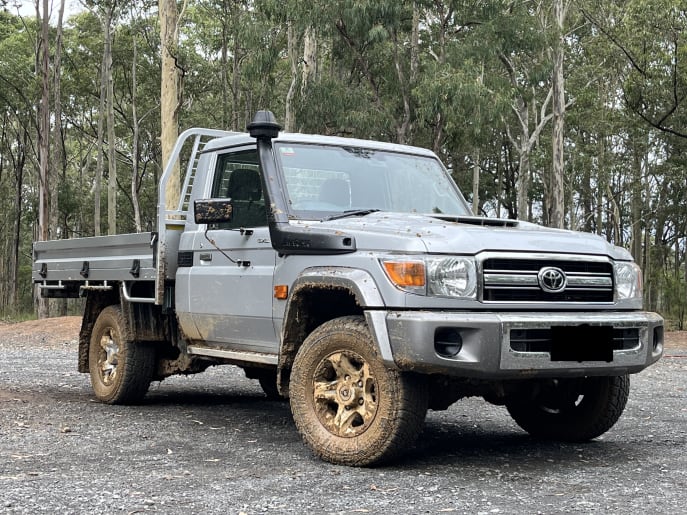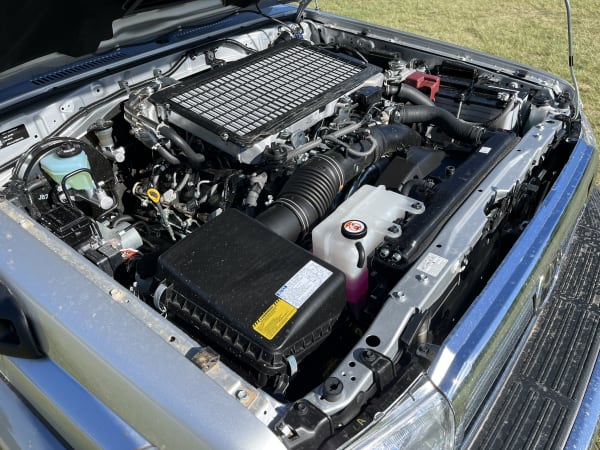The Toyota LandCruiser 70 Series is a legendary 4WD in Australia and beyond. And its long-time market-topping sales are a testament to its popularity.
It’s been a mainstay on remote-area properties, rural farms, and mine sites for donkey’s years. It’s been used extensively as an emergency services workhorse and has proven its worth as an all-conquering expedition vehicle time and time again.
The 79 Series, the ute of the 70 Series line-up, makes a lot of sense in those tough extreme scenarios mentioned above. But it doesn’t make a lot of sense in a city or suburban setting, because it’s big, heavy, uses a lot of diesel, and lacks refinement, practicality and driver-assist technology. It’s also expensive and there are lots of cheaper, better-equipped 4WDs available, yet, despite all those factors, there is still a lot of love about the 79. So much so, in fact, that Toyota has closed the order books for the entire line-up and waiting times have blown out to two years for some new buyers.
With the latest upgrade, the 79 finally has AEB (Autonomous Emergency Braking), GVM (gross vehicle mass) across the range has increased to 3510kg, and the price has gone up. But, apart from those things, nothing much has changed.
So is the 79 Series worth its near-$85,000 price tag? Or is it simply an old-school ute stuck in the past?
Price and features of the 2023 Toyota LandCruiser 79 Series GXL single-cab chassis
We spent seven days of mixed driving in the upgraded 79 Series single-cab chassis in GXL spec. And by “mixed driving” I mean we spent time on sealed roads getting to and from Sydney and around the Illawarra, as well as tackling a solid day in the bush, at the undisclosed location of our unofficial 4WD testing and proving ground. The purpose? Real-world testing of the 79 where it’s most comfortable: on hard-core 4WDing terrain.
But before we get stuck into how it performs off-road, let’s reel off a few of its features so you have a better understanding of what your money gets you when you spend it on a 79 Series.
Standard features include a 6.1-inch touchscreen multimedia system, with satnav, Bluetooth, Cruise Control, air-conditioning, power windows, Vehicle Stability Control with Hill-start Assist Control, 3500kg braked towing capacity, front and rear differential locks, a raised air intake (aka a snorkel) and 130-litre fuel capacity.
A 79 single-cab chassis in GXL spec costs about $76,650 (excluding on-road costs). Remember: that’s without a tray.
Our test vehicle has premium paint ($675), a general-purpose galvanised steel tray ($5864.98), a tyre hanger ($158.91), a tow bar ($797.17), trailer wiring harness (seven-pin flat, $273.90), and a towbar hitch receiver plug $5.97, so it’s price-tag totals $84,425.93 (excluding on-road costs).
There is a variety of exterior paint jobs for the 79: French Vanilla, Graphite, Merlot Red, Sandy Taupe, Midnight Blue and Silver Pearl (the colour of our test vehicle).
In terms of dimensions, this ute is 5230mm long (with a 3180mm wheelbase), 1870mm wide, and 1955mm high.
Without a tray, it has a listed kerb weight of 2195kg.
The 79 Series has a 4.5-litre turbo-diesel V8, producing 151kW at 3400rpm and 430Nm at 1200-3200rpm, and that’s matched to a five-speed manual gearbox.
All LandCruiser 79 Series have part-time 4WD with high- and low-range gearing.
There aren’t any surprises inside the cabin. The interior remains the same as it’s been since the ice age: cloth seats and durable plastic. Perfect for a ute that will endure a tough working life.
Storage spaces are limited to a small glove box, small centre console bin, cup holder, and the narrow area behind the seats where you can fit some soft bags or the like.
The 6.1-inch multimedia unit is easy to use, but the screen is tiny and there’s Bluetooth, but no Apple CarPlay or Android Auto.
There are two USB charge points as well as a 12V socket.
Driving the 2023 Toyota LandCruiser 79 Series
The LandCruiser 79 Series is not as atrocious on-road as you might assume, but it’s still on the wrong side of ordinary.
With a turning circle of 14.4m, the 79 feels similar to driving an overladen mini-bus. It’s floaty, cumbersome and it has a too-short first gear and crunchy gear-changes all the way through to a fifth that feels like it might benefit from another ratio above it.
An unladen ride can be bone-rattling jittery, even on sealed roads, as it is a ute after all.
But it’s a whole lot of fun to drive. It demands the driver’s full attention and rewards you with a visceral experience: it’s gruff, rough and agricultural. There’s also plenty of engine noise and wind-rush around the boxy frame, snorkel and wing mirrors.
The seats are surprisingly comfortable and, largely because of that, the cabin is very easy to spend long driving days in.
The 79 is purpose-built for 4WDing – with a separate chassis and live axles – and it is very effective off-road.
The part-time 4WD system is easy to use – you just work the stubby shifter near the gear stick – and the 79’s powertrain is perfectly suited to high- and low-range 4WDing, with heaps of torque at low revs.
The 79’s ground clearance is 316mm (unladen) and off-road angles are a guesstimated 35° (approach), 29° (departure) and 26° (ramp-over). Official wading depth is 700mm.
The 79 Series rides on Dunlop Grandtrek AT1 (265/70R16), decent light truck tyres in their own right, but think about replacing them with a set of more aggressive all-terrains if you plan to do a lot of 4WDing.
The 79’s 14.4m turning circle can be a challenge in the bush and some people have a problem with the 79 Series’ different wheel tracks front (1555mm) and rear (1460mm). But, though the mismatched tracks make for odd viewing from the rear, they’re not an issue while you’re driving.
The 79 has an unbraked towing capacity of 750kg, and a braked towing capacity of 3500kg.
Payload is listed as 1000kg (but it depends on the tray; our test vehicles tray was 315kg), and the Single-Cab Cab-Chassis GXL has a gross vehicle mass of 3510kg (up 10kg) and a gross combined mass of 6900kg.
The 79’s official fuel consumption is 10.7L/100km on a combined cycle. Our actual fuel consumption on the test was 12.5L/100km, calculated from fill to fill. The 79 has a 130-litre fuel tank – so, going by those figures, you could reasonably expect a driving range of about 1000km, out of the LC79’s 130-litre fuel tank, when doing a mix of road and dirt tracks, with some low-range 4WDing thrown in.
The 79 Series LandCruiser single-cab cab chassis has the maximum five-star ANCAP safety rating as a result of testing in September 2016. As standard, it now has AEB, driver and front passenger airbags, curtain shield and driver’s knee airbags, brake Assist, vehicle stability control, hill-start assist control, electronic brake-force distribution and active traction control.
All LC 70 series have a five-year/unlimited km warranty and capped price servicing over the first three years with an average cost per service of $340, totalling $2040 over three years.
Service intervals are scheduled for every six months or 10,000km, whichever is sooner.
What we think of the 2023 Toyota LandCruiser 79 Series
The 79 Series is great fun to drive for all of the reasons that make it such an oddity in a modern world: it’s big, boxy, noisy, and steers like a bus.
There’s no escaping the fact that it’s entirely impractical unless you live on a farm, work in a mine, or regularly do hard-core 4WD trips.
Also, there are plenty of cars that are much cheaper, a lot better equipped, far more functional, have more driver-assist tech, are much more comfortable, use less fuel and are much nicer to drive than the 79 Series.
Yet despite all of those reasons, it’s hard not to really enjoy driving this ute.














